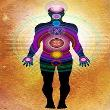Background
- Kundalini Yoga is one of many traditions of yoga that share common roots in ancient Indian philosophy. It is comprehensive in that it combines physical poses with breath control exercises, chanting (mantras), meditations, prayer, visualizations, and guided relaxation. It is an elaborate system focused on healing and "purifying" the mind, body, and emotions. Kundalini Yoga incorporates many aspects of other forms of yoga as well as related techniques of meditation and relaxation. It also offers teachings for all aspects of life including diet (vegetarian), serving others, and yogic life skills such as conscious parenting and partnering. However, the emphasis is more on breathing and meditation exercises, and less on challenging physical postures to build strength or flexibility, as is the emphasis in some other forms of yoga. Kundalini Yoga uses kriyas, specially formulated sets of exercises. There are traditional Indian kriyas and there are adapted Western versions.
- Kundalini Yoga is advocated as a way to keep the body in good condition and train the mind to be resilient and flexible in response to stress and change. Advocates claim that it increases oxygen capacity, boosts blood flow, balances the glandular system, strengthens the nervous system, and increases self-awareness, vitality, peace of mind, concentration, and self-confidence. It is recommended for people of all ages.
- The word "kundalini" stems from a Sanskrit term meaning "circular, coiled". It refers to the concept of the original creative energy of the universe, which is believed to be coiled up in a dormant state at the base of the spine in the coccyx. The practices are intended to awaken and activate this primal energy. It is believed that as kundalini awakens it uncoils and rises upward through the body, purifying the person in body, mind and spirit.
- The famous Swiss psychiatrist Carl Jung was interested in Kundalini Yoga as a supplement to his psychological theories. In 1932, Jung gave a series of lectures on Kundalini Yoga in Zurich (published under the title The Psychology of Kundalini Yoga by Princeton University Press in 1966). Yogi Bhajan, founder of the 3HO Foundation, introduced Kundalini Yoga in the West in 1969 with the goal of helping ordinary people to live healthy, conscious lives.
- While research in the broader field of yoga has documented benefits for stress reduction and quality of life in a variety of health conditions, including cancer, there has been little formal research in the techniques specific to Kundalini Yoga. More studies are needed to evaluate the contributions of Kundalini Yoga practices in health.
References
- Friedell, A. Automatic attentive breathing in angina pectoris. Minnesota Medicine 1948;31:875-881.
- Shannahoff-Khalsa, D. S. An introduction to Kundalini yoga meditation techniques that are specific for the treatment of psychiatric disorders. J Altern.Complement Med 2004;10(1):91-101.
View Abstract - Shannahoff-Khalsa, D. S., Boyle, M. R., and Buebel, M. E. The effects of unilateral forced nostril breathing on cognition. Int J Neurosci. 1991;57(3-4):239-249.
View Abstract - Jella, S. A. and Shannahoff-Khalsa, D. S. The effects of unilateral forced nostril breathing on cognitive performance. Int.J Neurosci. 1993;73(1-2):61-68.
View Abstract - Devi S, Chansouria JP, Malhotra OP, and et al. Certain neuroendocrine responses following the practice of Kundalini yoga. Alternative Medicine 1986;1(3):247-255.
- Shannahoff-Khalsa, D. Complementary healthcare practices. Stress management for gastrointestinal disorders: the use of kundalini yoga meditation techniques. Gastroenterol.Nurs. 2002;25(3):126-129.
View Abstract - Shannahoff-Khalsa, D. S. and Beckett, L. R. Clinical case report: efficacy of yogic techniques in the treatment of obsessive compulsive disorders. Int J Neurosci. 1996;85(1-2):1-17.
View Abstract - Shannahoff-Khalsa DS, Ray LE, Levine S, and et al. Randomized controlled trial of yogic meditation techniques for patients with obsessive-compulsive disorder. CNS Spectrums 1999;4(12):34-47.
- Nespor, K. and Cs, emy L. [Alcohol and drugs in Central Europe--problems and possible solutions]. Cas.Lek.Cesk. 8-22-1994;133(16):483-486.
View Abstract - Bernardi, L., Passino, C., Wilmerding, V., Dallam, G. M., Parker, D. L., Robergs, R. A., and Appenzeller, O. Breathing patterns and cardiovascular autonomic modulation during hypoxia induced by simulated altitude. J Hypertens. 2001;19(5):947-958.
View Abstract - Maevskii, A. A. [A complex of breathing exercises (hatha yoga) to arrest the developing attacks of dyspnea in bronchial asthma]. Klin Med (Mosk) 1995;73(4):87-88.
View Abstract - Puskarich, C. A., Whitman, S., Dell, J., Hughes, J. R., Rosen, A. J., and Hermann, B. P. Controlled examination of effects of progressive relaxation training on seizure reduction. Epilepsia 1992;33(4):675-680.
View Abstract - Bulavin, V. V., Kliuzhev, V. M., Kliachkin, L. M., Lakshmankumar, Zuikhin, N. D., and Vlasova, T. N. [Elements of yoga therapy in the combined rehabilitation of myocardial infarct patients in the functional recovery period]. Vopr.Kurortol.Fizioter.Lech.Fiz Kult. 1993;(4):7-9.
View Abstract - Sharma, I. and Singh, P. Treatment of neurotic illnesses by yogic techniques. Indian J Med Sci. 1989;43(3):76-79.
View Abstract - Reilly, R. Acute and prophylactic treatment of migraine. Nurs.Times 7-20-1994;90(29):35-36.
View Abstract - Winterholler, M., Erbguth, F., and Neundorfer, B. [The use of alternative medicine by multiple sclerosis patients-- patient characteristics and patterns of use]. Fortschr.Neurol.Psychiatr. 1997;65(12):555-561.
View Abstract - Schumacher J. Rehab for the heart. Yoga Journal 1985;(May/June):15-17.
- Telles, S. and Naveen, K. V. Yoga for rehabilitation: an overview. Indian J Med Sci. 1997;51(4):123-127.
View Abstract - Anonymous. Yoga relieves RA. Pulse of the Montana State Nurses Association 1991;May:2518.
- Anonymous. Yoga, meditation, help teen sex offenders. J Psychosoc.Nurs.Ment.Health Serv. 1999;37(6):6.
View Abstract - Nespor, K. [Occupational stress in health personnel and its prevention. Possible use of yoga]. Cas.Lek.Cesk. 8-3-1990;129(31):961-964.
View Abstract







